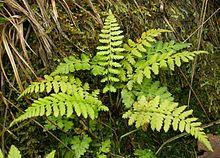| Cystopteris | |
|---|---|
 | |
| Cystopteris fragilis | |
| Scientific classification | |
| Kingdom: | Plantae |
| Clade: | Tracheophytes |
| Class: | Polypodiopsida |
| Order: | Polypodiales |
| Suborder: | Aspleniineae |
| Family: | Cystopteridaceae |
| Genus: | Cystopteris Bernh. |
| Species | |
| 10-20: see text | |
| Synonyms[1] | |
| |
Cystopteris is a genus of ferns in the family Cystopteridaceae.[1][2] These are known generally as bladderferns or fragile ferns. They are found in temperate areas worldwide. This is a very diverse genus and within a species individuals can look quite different, especially in harsh environments where they experience stress and remain small and stunted. Also, they hybridize easily with each other. Identifying an individual can be challenging. In general these are rhizomatous perennials which may grow in rocky areas or in soil. Their leaves are multiply pinnate, in that each leaflet is divided into smaller parts. The sori are usually rounded and are covered in an inflated bladder-like indusium.
Species
- Cystopteris alpina
- Cystopteris bulbifera - bulblet fern
- Cystopteris chinensis (Ching) R.Wei & X.C.Zhang (syn. Cystoathyrium chinense Ching)
- Cystopteris diaphana
- Cystopteris dickieana - Dickie's bladderfern
- Cystopteris douglasii - Douglas' bladderfern
- Cystopteris fragilis - brittle bladderfern
- Cystopteris laurentiana - St. Lawrence bladderfern
- Cystopteris montana - mountain bladderfern
- Cystopteris protrusa - lowland bladderfern
- Cystopteris reevesiana - Reeves' bladderfern
- Cystopteris tennesseensis - Tennessee bladderfern
- Cystopteris tenuis - upland brittle fern
- Cystopteris utahensis - Utah bladderfern
Hybrids
Cystopteris widely hybridizes internally.
North American Cystopteris hybrids
The diploid parent species within the genus include:
- C. bulbifera
- C. "hemifragilis" (an undiscovered or extinct diploid)
- C. protrusa
- C. reevesiana
The hybrid species include:
- C. fragilis (C. "hemifragilis" × C. reevesiana; allotetraploid)
- C. laurentiana (C. bulbifera × C. fragilis; allohexaploid)
- C. tennesseensis (C. bulbifera × C. protrusa; allotetraploid)
- C. tenuis (C. "hemifragilis" × C. protrusa; allotetraploid)
- C. utahensis (C. reevesiana × C. bulbifera; allotetraploid)
Non-species hybrids include:
- Cystopteris × illinoensis (C. bulbifera × C. tenuis; allotriploid)
- Cystopteris × wagneri (C. tennesseensis × C. tenuis; allo-allotetraploid)
- Cystopteris fragilis × Cystopteris tenuis (allo-allotetraploid)
- Cystopteris protrusa × Cystopteris tennesseensis (allotriploid)
References
- ^ a b PPG I (2016). "A community-derived classification for extant lycophytes and ferns". Journal of Systematics and Evolution. 54 (6): 563–603. doi:10.1111/jse.12229. S2CID 39980610.
- ^ Maarten J. M. Christenhusz, Xian-Chun Zhang & Harald Schneider (2011). "A linear sequence of extant families and genera of lycophytes and ferns" (PDF). Phytotaxa. 19: 7–54. doi:10.11646/phytotaxa.19.1.2.
- ^ Cystopteris Bernh. Tropicos.org. Missouri Botanical Garden. 29 Feb 2012
- ^ Hassler, Michael & Schmitt, Bernd (June 2019). "Aleuritopteris". Checklist of Ferns and Lycophytes of the World. 8. Retrieved 14 August 2019.
- Lellinger, David B. A Field Manual of the Ferns & Fern-Allies of the United States & Canada. Smithsonian Institution, Washington, DC. 1985.